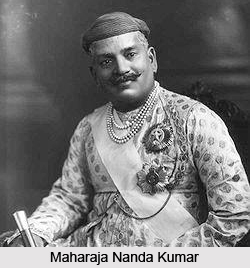Trail of Raja Nand Kumar – the judicial murder. (1775).
The trial of Raja Nand Kumar is an example of how arbitrary and capricious the justice of administration was in British India. This trial is popularly known as the judicial murder of Raja Nand Kumar. This is a historically significant trial because later on this trial became a major ground for the impeachment of Governor General Warren Hastings and Chief Justice Impey of the Supreme Court of Calcutta, by the House of Commons, after they returned to England.
Events prior to the commencement of trial
Raja Nand Kumar, who was once Governor of Hugli under Nawab Siraj-Ud-Daulah in 1756 and later due to his loyalty to the English Company in 1757 was nicknamed “Black Colonel “during Clive’s period, brought several charges of bribery and corruption against Governor-General Warren Hastings, in 1775. Raja Nand Kumar gave a letter of complaint against Warren Hastings, to Francis, a member of the council dated 11th March 1775. This letter was presented before the Council by Francis, the same day, at its meetings. The letter of complaint stated that in 1772 Warren Hastings when he was Governor, accepted from him as a bribe of Rs.1,04,105/- for appointing Gurudas as Diwan and from Munni Begam Rs.2,50,000/- for appointing her guardian of the infant Nawab Mubarak-Ud-Daulah. The Council received another letter from Nand Kumar dated 13th March 1775 through which he offered to produce vouchers supporting his charges of bribery against Warren Hastings. In the council meeting, a motion by Monson was moved to ask Nand Kumar to appear before it. This motion was opposed by Warren Hastings who was presiding at the meeting. Notwithstanding Hasting’s opposition, the Monson’s motion was carried by a majority of votes in the Council. This irked Hasting and he dissolved the meeting of the Council and left the seat. The Council elected Clavering to occupy the presiding seat at the meeting. Raja Nand Kumar, after appearing before the Council, produced a letter in Persian, which was written by Munni Begum to him. The Council, while examining Raja Nand Kumar, asked him that, “Was he ever approached by Warren Hasting or his men for the letter of Munni Begum?” In response to this question, Raja Nand Kumar said that Warren Hasting’s Baniya Kanta Babu had come to him, nearly four months ago to collect this letter, but the original letter was not provided to him. The Council also called Kanta Babu, but he avoided appearing at the instance of Warren Hastings. The Council found the charges of Raja Nand Kumar, against Warren Hastings to be true and held that he received a sum of Rs.3, 54,105/- as a bribe and therefore the Council by a resolution directed Warren Hastings to pay the same amount into the Company’s treasury.

Facts of the Case in the trial of Raja Nand Kumar.
Raja Nand Kumar was arrested, a few months later, with Fawkes and Radhacharan, for conspiracy at the instance of the Governor General and Barnwell. Warren Hastings and his favorite Council member Barewell declared their intention before the judges of the Supreme Court, to prosecute Raja Nand Kumar, the Fawkes, and Radhacharan for conspiracy. The trial of Raja Nand Kumar, for conspiracy, continued with another trial of his for forgery. The Supreme Court delivered its judgment in July 1775, in the conspiracy case. Fawke was fined, but the judgment was reserved against Nand Kumar on account of the forgery case. The Governor-General Warren Hastings felt that it would be difficult to involve Nand Kumar directly in the conspiracy case and therefore he implicated Nand Kumar in another case of forgery, for which the punishment was death as per the provisions of the English Act of 1729. The charge of forgery against Nand Kumar, was with respect to a bond or deed claimed as an acknowledgment of debt from Bulaki Das, the banker, which it is said, was executed by him in 1765. Mohan Prasad brought a charge of forgery on 6th May 1775 before the justices of the peace for the town of Calcutta. Le Maistre and Hyde acted as Magistrates, they heard the case and scrutinized the evidence for the prosecution till late in the night. The Magistrates, in the capacity of the justices of the peace, being satisfied with the evidence of the prosecution witnesses, ordered the Sherrif and keeper of His Majesty’s prison at Calcutta to keep Nand Kumar in safe custody until he would be released as per law. Mohan Prasad gave a bond to prosecute Nand Kumar in the Supreme Court dated 7th May 1775, and on this basis, his trial commenced before the Chief Justice and three other puisne judges of the Supreme Court on 8th May 1775.
The trial of Nand Kumar began on 8th June and continued for eight days without any postponement. The advocate of Nand Kumar, first of all, advanced a plea as to the jurisdiction of the Supreme Court in the matter, which was rejected by the Court. The Court sat every day from 8 a.m. and witnesses were scrutinized till late at night. One of the most peculiar features of this trial was that the judges cross-examined the defense witnesses in minute detail on the plea that the King’s Counsel was incapable of doing it efficiently. It raised a serious question mark on the integrity and the impartiality of judges. The trial lasted till the midnight of 15th June 1775. The Chief Justice Impey summed up the whole case on the morning of 16th June. The judges gave the unanimous verdict of “guilty,” and the jury also declared their verdict of “guilty.” The Chief Justice after rejecting all pleas to defend Raja Nand Kumar, sentenced him to death under an Act of the British Parliament which was passed in 1729. Every possible attempt to save Raja Nand Kumar was made but to no avail. The advocate of Raja Nand Kumar decided to take an appeal to the King-in-Council and petitioned the Court to stay the implementation of the decision so long as the Council’s decision was not known. The Court rejected the petition. The efforts to seek the assistance of the members of the Council also proved in vain. The letter of recommendation by the Nawab to the Council, to suspend the sentence until the pleasure of His Majesty was known, also proved to be futile, since the Supreme Court took no action upon it after being forwarded by the Council. Raja Nand Kumar was thus hanged on 5th August 1775 at 8:00 a.m. at Cooly Bazar near Fort William.
Two Important question raised in the trial
In this trial, two very important questions emerged. The first, whether the Supreme Court had jurisdiction in this matter? Second, whether the English Act of 1729, which made forgery a capital offense, was extended to India? The prime objection regarding the Supreme Court’s jurisdiction was that before the establishment of Supreme Court in Calcutta, the Indians in Bengal were tried by local Faujdari Adalats. In this case, the offense was committed before the establishment of the Supreme Court, and therefore it had no jurisdiction to decide the case. On the second issue of applicability of the Act of 1729 to India, there was a divided opinion even amongst the judges, but ultimately the majority views including that of the Chief Justice Impey prevailed.
Thus the decision of the Supreme Court, in this case, created a huge controversy and depicted the arbitrary state of the administration of justice in India. This decision was widely criticized and popularly referred to as judicial murder of Raja Nand Kumar.
Further, Read More:
Does ModiJi’s business bond have Gandhi’s instinct of reprimanding influential industrialists?



